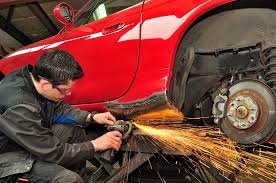Post Preview
The first step in any auto body repairs is the initial damage assessment. When you bring your car to a shop, technicians will thoroughly inspect the vehicle to determine the extent of the damage. This step is critical as it dictates the scope of the work ahead. For instance, a small car accident may only need minor cosmetic fixes, while more severe collisions could require straightening the frame or replacing parts. A thorough evaluation ensures that all apparent and hidden damages are taken into account, preventing potential issues that might result from overlooked damage.
Obtaining Repair Estimates
Once the assessment is complete, the shop will provide you with a detailed repair estimate. This estimate will include costs for parts, labor, and any additional services needed. It’s a good idea to obtain estimates from multiple shops to ensure you get a fair price. For those in the Everett area, you might consider visiting an auto body shop & paint shop in Everett, WA to get a comprehensive repair estimate. Comparing quotes from various shops can also give you insight into the standard pricing for the type of repair required. Be sure to ask for itemized estimates to clearly understand what you are being charged for and don’t hesitate to question any ambiguous charges.
Approval and Insurance
Once you have examined the projections, you must give your approval for the task. When submitting an insurance claim, the approval of the cost from your insurance provider is required as well. This process can be time-consuming at times, especially if extra approvals are needed for additional repairs. Understanding your insurance policy can expedite the process and help avoid unexpected delays. Familiarize yourself with your insurance coverage and any stipulations that might affect your claim, such as deductibles and rental car eligibility. Effective communication between you, your insurer, and the repair shop can significantly streamline this stage.
The Repair Process
With approvals in place, the repair process can begin. Depending on the damage, this could involve multiple stages. Technicians might start with structural repairs, followed by cosmetic work like painting and finishing. Advanced repair shops use state-of-the-art technology to ensure precise fixes. For instance, laser-guided frame straightening ensures that your vehicle’s framework is returned to its original specifications. The repair process not only focuses on fixing the visual damage but also aims to restore the car’s safety features. During this phase, any damaged safety systems such as airbags or electronic sensors will be checked and repaired to ensure the vehicle is roadworthy once more.
Structural Repairs
Structural repairs involve aligning a car’s frame and sub-assemblies to restore its structural integrity and safety. Misalignment can affect handling and overall safety. Technicians use computerized systems to measure and correct deviations, ensuring accurate frame alignment for predictability in collisions and occupant safety. Improper structural repairs can lead to further mechanical issues, so choosing a shop with precise alignment technology is crucial.
Cosmetic Repairs and Painting
After structural repairs, the focus shifts to cosmetic fixes like dent repair, filler application, sanding, and painting. Modern auto body shops use advanced paint-matching technology to ensure a seamless color blend. High-quality repairs significantly impact vehicle performance. Proper paint jobs involve multiple layers and adequate drying times to prevent peeling or bubbling. The final result protects the metal underneath from rust and weather damage.
Quality Control
Once repairs are completed, the shop will perform a series of quality control checks. These inspections are crucial to guarantee that the car is safe to drive and that all repairs adhere to industry standards. They may involve road testing the car and double-checking the integrity of the repair work. Quality control also includes a final inspection where technicians review all aspects of the repair to ensure everything is perfect. This stage is critical for verifying that the paint matches and blends seamlessly, that all repaired parts function as intended, and that there are no remaining safety issues. Sometimes, shops will provide a warranty on their work, offering peace of mind that any defects will be addressed post-repair.
Final Delivery
After quality control, the shop will prepare your car for final delivery. You’ll have an opportunity to inspect the repairs and ensure everything is to your satisfaction. Never be afraid to clarify things or ask for minor changes if necessary. Effective communication during this last stage can significantly impact how satisfied you are with the repair procedure overall. Take your time to check that all requested repairs have been completed to a high standard, test any repaired features and examine the paint job under various lighting conditions. Transparency from the shop at this stage can help ensure you are confident in the work done on your vehicle.

